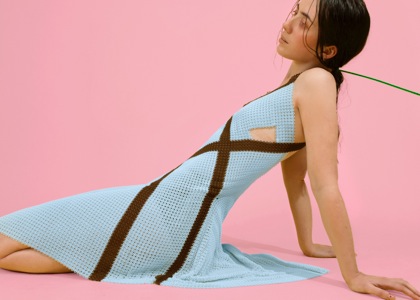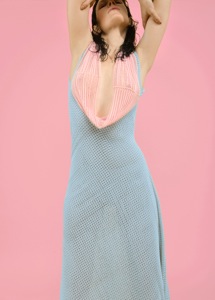
The fashion industry has seen its fair share of 3D printed innovation, which has hit catwalks all over the world and been incorporated into the collections of designers such as Iris van Herpen, Chanel and Noa Raviv, among others.
To date, though, as desirable and innovative as this work has been, the clothes themselves have not been particularly accessible or wearable. This angle has been central to the MODECLIX project at the University of Hertfordshire (UH), which recently unveiled a new prototype collection of wearable 3D printed garments.
And yes, the emphasis is very much on the wearability of the 3D printed clothes. Developed in collaboration between Shaun Borstrock, Associate Dean for Business and Innovation at UH and the architect behind the project, and renowned 3D specialist and designer Mark Bloomfield (electrobloom) the MODECLIX project was commissioned to successfully develop items of clothing that are uniquely customisable and wearable.

According to Shaun, the wearability issue was addressed by designing and 3D printing textiles that are flexible with movement and that mimic traditional cloth and he believes that the complex design process involved in making these garments represents a breakthrough for garment technology and 3D printing. The project focuses on an interpretation of weave, stitch and knit such that the initial prototypes are 3D printed as pieces of textile that have enough movement to ensure that they are fluid and represent a ‘fabric’ that can be used to make a garment in the traditional sense, by piecing the fabric together to generate the desired, customized to fit aesthetic.
The MODECLIX collection features eight dresses and two headpieces that can each be customised to any size and shape either before printing or after, by adjusting the intricate links to fit by hand. The fabric is produced on an industrial 3D printer — the EOS Formiga, which processes a white Nylon powder. Printing time varies depending on complexity, but on average, printing enough components to complete a dress takes 62 hours. Once out of the machine, the white 3D printed components are then cleaned, vibro finished and hand dyed and subsequently constructed using traditional dress making techniques using a dressmaking stand to drape and form the pieces, linking panels together to create the final form. This video gives a simultaneously glossy and realistic impression of the process — masks included.

All of the dresses in the collection have been designed to flatter the wearer’s natural shape without compromising on style or comfort — the model in the images was specifically asked about this and said it was surprisingly comfortable to wear – standing and sitting (I checked!). All of the dresses will be premiered in April at the Mercedes-Benz Bokeh South Africa International Fashion Film Festival.
Beyond that, Dr Borstrock, wants to see 3D printed clothes out in the wider world: “These prototypes are made, dyed and finished by hand and our aim now is to produce them for a wider market. It will only be a matter of time before we see 3D collections on the high street and 3D printing technology in stores as part of everyday life. We’re pleased to be part of the movement that is exploring how this might become a reality.”
Mark Bloomfield, Managing Director of electrobloom further commented, “I’ve spent the last 25 years exploring how technology and 3D printing can enhance production techniques for jewellery and accessories, and this has been a fantastic opportunity to take this research even further. There is a huge amount of potential to develop complex construction techniques that defy traditional pattern cutting and create garments that are multi-functional, customisable and wearable.”
The collection will available to view online from 1 May 2016 at digitalhacklab.herts.ac.uk and modeclix.com [note, not yet open]. It will also be available to view in store from 23 May 2016 at electrobloom, Studio 2.11 , Oxo Tower Wharf, Bargehouse Street, London.
Via University of Hertfordshire and MODECLIX (After May 1)
Image Credit: Agnes Lloyd Platt

